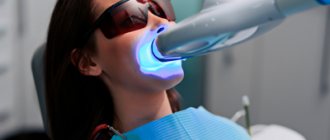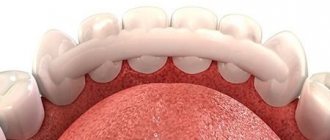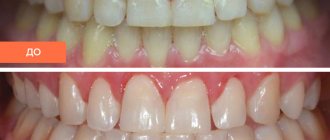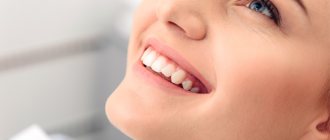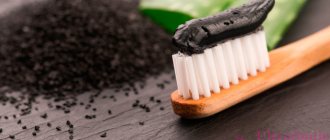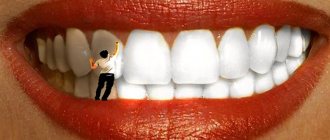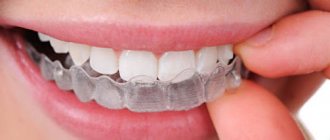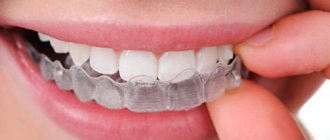Today, teeth whitening is considered an affordable procedure that will help make your smile even more beautiful. And indeed it is. Therefore, in the absence of contraindications, there are no arguments against whitening. It's safe, comfortable and fast. We offer patients a choice of several effective whitening systems:
- Amazing White,
- Opalescence,
- Zoom 4,
- Klox,
- Philips Zoom QuickPro.
Next we will look at each of them in detail.
When going to the clinic, you should be prepared for the fact that not everyone recommends teeth whitening using one of the popular methods. There are situations when uneven teeth, the presence of fillings in the smile area, a specific natural shade of enamel or other nuances will not give the maximum result after whitening procedures. Sometimes the doctor will recommend other methods: whitening pen, trays or strips. You can find out about the presence of contraindications, as well as get advice on choosing the optimal system, during a consultation with our dental hygienist.
Advantages and disadvantages of the procedure
Positive sides:
- Quick results. In a single visit, you can noticeably lighten the enamel by several tones, the effect depends on its condition.
- No medical indications. The client of the dental clinic decides for himself whether he needs to whiten his teeth.
- Many methods with different effects and prices.
- No pain or other discomfort.
- Almost all methods are universal, which means they can be used for patients of different ages.
- There is no need to go through a recovery period.
- Getting rid of complexes and awkwardness when communicating with others.
The technique also has negative aspects:
- The most effective methods have a high cost.
- The effect does not last long. The smile will remain snow-white for 5-7 years, but no more.
- Increased sensitivity of enamel, its thinning. Pain may occur while eating if the food or water is too cold or too hot.
- Inability to change the color of filling material, implants, artificial crowns.
- The risk of losing the natural shade of teeth and excessive whiteness increases.
- The need to adhere to dietary nutrition to maintain results. It is not recommended to drink coffee, strong black tea, or eat foods with a high concentration of bright natural pigment.
Advantages of Zoom 4 technology
Zoom 4 technology is many times superior to competitive teeth whitening procedures in many ways:
- absolute safety - the procedure does not destroy tooth enamel, does not damage the pulp and does not cause gum burns;
- high efficiency - one procedure is enough to remove many years of plaque from cigarettes and coffee, remove signs of fluorosis and tetracycline stains on enamel;
- high degree of lightening - in one procedure, teeth become 8-10 shades whiter;
- quick results - the procedure takes no more than 45 minutes including preparation;
- long-term preservation of the result - teeth remain snow-white for at least 4 years.
In contrast to the advantages, there is only one drawback of the Zoom 4 method - the relatively high cost of whitening, which is compensated by the excellent result.
Contraindications to teeth whitening
Doctors recommend completely abandoning the procedure or postponing it indefinitely during pregnancy and breastfeeding, as well as when:
- individual intolerance to the components of the whitening composition;
- the presence of a milk bite that has not changed to a permanent one;
- oncology;
- increased sensitivity of enamel;
- tissue damage due to traumatic exposure or other reasons;
- pulpitis in chronic form;
- orthodontic treatment;
- dental diseases (for example, caries) in the acute phase;
- a large number of fillings, fixed dentures, artificial crowns (possible color balance disturbances, unnatural whiteness of certain areas).
Each case is reviewed by a dentist; the doctor may prohibit lightening of the teeth to avoid adverse reactions. Why do you need teeth whitening if it will lead to irreversible consequences? It is likely that the presence of the above circumstances is not an absolute obstacle to a cosmetic procedure, and in the absence of dangerous risks it can be completed.
Composition of whitening gels
For various methods of professional and non-professional teeth whitening, special whitening gels are used, the active substances of which are hydrogen peroxide or carbamide. Sometimes the preparations include amorphous calcium phosphate, fluoride or potassium nitrate to treat minor damage to the enamel, as well as to make teeth brighter and glossier after the procedure. In some cases, the whitening gel may contain special components that have a soothing effect on the teeth and gums.
How to reduce harmful effects
A dazzling smile does not mean that your teeth are completely healthy. Behind the thin enamel is dentin. It is a structure with yellowish or grayish pigmentation. Whitening uses active chemical compounds that lead to thinning of the enamel layer or damage to its integrity. This also affects the condition of the oral cavity.
To minimize negative consequences, the dentist performs the following actions:
- Conducts a visual inspection and assessment of the condition of hard and soft tissues in the mouth.
- Identifies possible contraindications.
- Selects a safe and effective method of teeth whitening.
- Uses any available methods to diagnose and relieve pathological processes.
How to keep your teeth white longer
Depending on the technique used, the effect of professional whitening can last for more than one year. However, some patients return to the clinic after a few months for a repeat procedure. To ensure that your smile remains dazzling for a long time, doctors recommend adhering to the following rules:
- do not eat for 3 hours after teeth whitening, you can only drink clean water, then you must adhere to a special diet;
- Do not use a brush with hard bristles, as this will only increase sensitivity;
- purchase a paste without abrasive particles;
- rinse your mouth, use dental floss, and irrigator after each meal;
- Mouth rinses should not contain chlorhexidine (it stains teeth);
- follow a schedule of visits to the dentist for preventive examinations (at least once every six months);
- complete smoking cessation for 2-3 days, preferably for several weeks.
Special diet
To maintain the effect for a long time immediately after the procedure, you must adhere to a special diet. It is important to minimize the consumption of foods with bright colors. It is advisable to eat:
- porridge;
- dairy (but not fermented milk) products;
- fish and seafood;
- chicken, rabbit;
- egg white;
- white fruits and vegetables (such as bananas).
Along with eliminating food containing dyes from the diet, it is recommended to avoid coloring spices. This is turmeric, paprika. Dentists also do not advise eating smoked meats, citrus fruits, any berries, drinking coffee, black tea and alcoholic beverages.
Types of teeth whitening: pros and cons
There are no ideal lightening methods. Each has positive and negative sides that the patient must be prepared for. This is why you need to consult your dentist first.
Mouthguards
These are removable devices that are made of special materials that are not subject to oxidative processes. As a rule, structures are used to correct bites and change the position of teeth. If the mouth guard is installed correctly, it does not cause discomfort (pain or other discomfort). After the adaptation period, the patient completely forgets about the presence of a foreign object in the mouth.
The device is created from an impression, which the dentist first makes during the initial appointment. The finished structure is filled with a whitening agent and placed on the upper or lower jaw.
Advantages:
- low cost compared to other methods;
- Possibility of teeth whitening at home.
Flaws:
- insufficient visual effect, mouth guards will not get rid of intense yellowish deposits;
- risk of developing an allergic reaction;
- The method is contraindicated for persons with orthodontic structures in the mouth (plates, braces, etc.).
Laser technique
This method is one of the most effective. You can walk with a snow-white smile for up to 10 years, of course, if you do not ignore medical instructions. In this case, the enamel becomes white in just one session.
A gel composition is applied to the teeth, after which its components are activated using a laser, oxygen ions are formed, which penetrate the enamel layer and deactivate the coloring pigment.
Pros:
- To lighten by more than 5 tones, one visit to the clinic is enough;
- absence of pain and other discomfort;
- the device operates for a short time (about 20 minutes);
- the gel used has antiseptic properties and prevents inflammatory processes in the mouth;
- the components of the drug strengthen the enamel and protect it from external influences.
Negative sides:
- high price compared to alternative methods;
- increased tooth sensitivity immediately after the procedure.
Ultrasonic cleaning
In this case, enamel lightening occurs due to the removal of hard plaque and other deposits, even in the interdental spaces. With the help of vibrations, all layers are mechanically removed. After all the manipulations, the specialist applies a special paste-like composition to the teeth to improve the protection of the dentition from external influences and various chemical irritants.
Ultrasound helps to get rid of even subgingival plaque. The stone is also removed.
Pros:
- in one visit to the dentist you can lighten your teeth several shades;
- during the procedure, the entire oral cavity is cleaned, and not just hard tissues;
- absence of pain and other unpleasant sensations;
- affordable price.
Minuses:
- To consolidate the effect, ultrasonic cleaning should be repeated annually;
- the result may seem insufficient if the enamel is too dark;
- the natural shade of dentin tissue does not change;
- A visit to the doctor takes up to an hour.
Chemical bleaching
The dentist applies highly concentrated preparations that contain hydrogen peroxide or other active ingredients. As a result, dentin is whitened, its shade becomes lighter by 5-7 tones or more.
Advantages of the method:
- an effective procedure that removes plaque and lightens the dentinal layer;
- if all manipulations were performed according to the rules, the result can last up to 4-5 years.
Minuses:
- increased sensitivity of enamel after lightening;
- high price;
- the risk of burns to the mucous membranes if the dosage regimen of the chemical composition is not followed;
- It takes many procedures (about 7) at intervals of 2-3 days to achieve the desired effect.
Air Flow
The surface of the teeth is processed mechanically, without affecting the dentinal layer. The doctor uses a sandblasting machine for this. Even the most difficult to reach areas (for example, interdental spaces) will be clean after exposure to a mixture of water, air and soda. The enamel is polished and the smile becomes dazzling.
Advantages:
- absence of pain and other discomfort;
- the entire oral cavity is cleansed, including the space between the teeth, under the gums, etc.;
- fabrics are not damaged, abrasive particles act very gently;
- the patient is not bothered by increased tooth sensitivity immediately after brushing;
- affordable price.
Minuses:
- insufficiently expressed visual effect;
- a greater number of contraindications compared to alternative methods;
- the color lasts up to a year.
Photobleaching
One of the most modern techniques with ZOOM or Luma-Arch devices. The enamel brightens due to ultraviolet exposure. The lamp warms up the lightening gel applied to the teeth, thereby enhancing its effect.
Pros:
- the procedure lasts about 15 minutes;
- per visit you can make the enamel 10 shades lighter;
- the effect lasts up to 4 years if you follow the rules established by your doctor and adhere to basic hygiene standards;
- absence of pain syndrome.
Minuses:
- high cost (methods involving mechanical cleansing will be much cheaper);
- It is advisable to completely exclude foods with bright dyes from the diet;
- subsequent remineralization may be required;
- before photobleaching, it is necessary to remove microprostheses and veneers;
- bleaching is uneven, hard-to-reach areas are not lightened, but only the front incisors and canines;
- If the procedure technique is not followed, the risk of burns to the mucous membranes of the oral cavity increases.
Endobleaching
This technique is also called in-canal bleaching. This method is used when depulpation has been performed, that is, removal of palpable tissue. After the death of the nerve, the teeth darken, so many patients want to lighten them.
The doctor pours a special synthetic composition with a whitening effect into the cavity and places a temporary filling material on top. If the enamel becomes lighter within 10-15 days, the drug is removed and everything is filled.
Advantages:
- you can lighten one or several teeth at once;
- the enamel remains intact because the whitening agent acts from the inside.
Flaws:
- short-term effect (up to a year);
- not suitable for processing both rows;
- the price increases as the number of teeth treated increases.
Home whitening
Not all patients want to visit a dental clinic and prefer to whiten their enamel at home. The most common procedures:
- The use of special whitening pastes. Typically, such compositions contain abrasives, affecting the entire surface of the dentition. As a result, it is possible to lighten the enamel layer by several tones.
- Special stripes. They resemble a plaster and are glued to the incisors of the upper and lower jaws. The adhesive side contains a gel with concentrated chemical compounds. An oxidation process takes place in the mouth, which promotes quick and easy cleansing.
- Traditional methods. Fans of “grandmother’s” recipes use hydrogen peroxide, soda, activated carbon and other substances.
What are the advantages of self-lightening at home:
- low price;
- ease of implementation.
The list of disadvantages is much more extensive than the list of advantages. This:
- low effectiveness compared to professional care;
- negative impact on enamel, damage to the mucous membranes of the oral cavity, the appearance of hypersensitivity to any irritant;
- high risk of allergies and poisoning due to careless use and, as a result, ingestion of bleaching mixtures.
Alternative Methods
We looked at the main ways to lighten an enamel coating. At the same time, there are techniques that are not classical, but can visually make a smile snow-white. These are intracanal endobleaching and microprosthetics with veneers. The intracanal bleaching technique may be necessary if the tooth has darkened due to pulp removal, trauma, or the use of a colored filling material. Endobleaching involves the introduction of a lightening gel into the cleaned canal, which destroys the pigment. If the teeth are slightly uneven, have a chip or crack, and in addition their color is far from ideal, then the best option in this case would be to install veneers. These are the thinnest plates fixed to the outer surface of the dental elements. At the same time, they are sharpened minimally, and the aesthetics of the smile changes for the better as much as possible.
Is teeth whitening worth it?
This is a very responsible procedure; if you make mistakes, you can start irreversible pathological processes. Doctors recommend dental cleanings twice a year to remove accumulated plaque. This is a superficial method that does not lighten the dentition. If a patient wants to whiten his teeth, he is indicated for professional whitening in dentistry.
Doctors do not recommend performing the procedure at home with store-bought pharmaceutical formulations. Firstly, it is very difficult to correctly calculate the dosage that will be safe for the enamel and for the entire body if accidentally swallowed. Secondly, even one careless action can lead to burns of the mucous membranes.
After lightening the enamel, you need to be prepared for sensitivity to temperature changes, sour, sweet, and solid foods. In addition, careful hygiene and diet will be required, which not everyone is ready for.
Having studied the indications and contraindications for professional cosmetic teeth whitening, the pros and cons of the procedure, you can choose a technique that is right for you. We invite you to sign up for a preliminary consultation with a Dentiki dentist by calling the number listed on the website or filling out the feedback form.
Prices for services
| Service | Price | Installment plan 0% monthly (x12) |
| Whitening ZOOM 4 (2 jaws) generation 2022 | 28500 rub. | RUB 2,350 |
| Professional teeth cleaning Clinpro | 6,900 rub. | — |
| Remineralization of teeth (entire cavity) | 2,800 rub. | — |
| Ultrasound removal of tartar (entire cavity) | 2,800 rub. | — |

